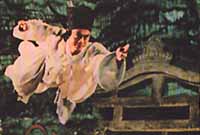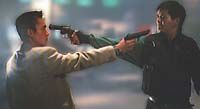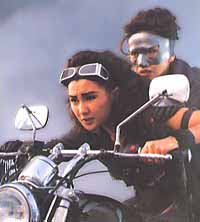




| Everything You Always Wanted to Know About Hong Kong Action Cinema by Gary Johnson |
|
Most articles and books about Hong Kong cinema only look at films from the early '80s to the present, neglecting the wealth of movies made throughout the previous decades. For these authors, Hong Kong cinema didn't really begin until John Woo broke the mold with his hyper-kinetic violent action movies, and for others it didn't begin until Jackie Chan emerged as a big star in the '80s. |
Oh, you might get a cursory summation of Bruce Lee's career or a mention of the Shaw Brothers, but the older martial arts stuff was unfortunately considered irrelevant.
One of the intentions of a new book by Bey Logan, Hong Kong Action Cinema, is to restore the older movies to their proper place in history. The book takes a look at the long history of Hong Kong cinema, giving us big doses of Peking Opera and Wong Fei Hung before delving into the "Ballistic Ballet of John Woo" or "the Clown Prince of Kung Fu" (Jackie Chan). In addition, we get entire chapters devoted to Bruce Lee and Lau Kar Leung. |
Thanks to his approach, Hong Kong cinema emerges for American readers as not just a recent development, but a cinema with a history that stretches back into the '50s--a relatively young cinema, yes, but one with a history that is three or four times deeper than many other writers would have us believe.
But even when it comes to the more recent developments of Hong Kong cinema, Logan directs our interest toward performers frequently undervalued in America, such as Samo Hung, or to genres not fully appreciated in the West, such as Hong Kong comedies (one of the most loved genres in Hong Kong itself), and points out that many of the violent movies hailed as brilliant in the west actually did only so-so business in Hong Kong. About John Woo's The Killer, for example, Logan quotes Chow Yun Fat as saying, "A lot of the audience can't stand [the violence]. I myself don't like violence."
Logan, a performer himself in martial arts movies (and the editor of Impact: The Action Movie Magazine), gives us access to many inside stories on the filmmaking in Hong Kong--from the on-set tension between director Lo Wei and star Bruce Lee during the making of Fist of Fury to the eyeball gouging scene that mercifully didn't make it into the final print of Ringo Lam's operatic-pitched ode to violence Full Contact. Logan writes as a real insider in the Hong Kong film industry, who has dug up stories and anecdotes on most all the movies he discusses.
As much as I enjoyed Hong Kong Action Cinema, however, I kept wishing for more than the background stories on the filmmaking. I wanted some more insight into the movies themselves. For example, when Logan discusses The Protector, he says there is a difference in technique between the scenes filmed by American director James Glickenhaus and the additional footage shot by Jackie Chan after Glickenhaus returned to the states: "the two versions of the Chan/Wallace fight are a perfect lesson in the difference between the American and Chinese philosophies of movie martial arts choreography." But Logan doesn't then follow through and discuss what those differences are. When he discusses Savior of the Soul, he suggests it's the movie that Highlander 2 should have been: "This is particularly obvious in the opening sequence, when a lone and lethal swordsman hacks his way, with considerable style, into a high-tech, high security prison." But you have to have seen the movie (and he's right, it is an incredible scene) to know what he's talking about.
The book could have used more discussion of the scenes to help the reader understand Hong Kong cinema, but Logan seems suspicious of analysis. He seems to know a good fight scene when he sees one, but he doesn't know how to describe what makes a good scene work, other than providing bland descriptions, such as "surprisingly effective" (what made it effective?) and "perfect balance" (why did the balance of opposing qualities make the movie work?).
The book also manages to completely disregard some of the biggest cult movies from Hong Kong, such as Naked Killer (no mention whatsoever) and The Bride with White Hair (only a cursory mention).
But don't let these misgivings detract you from picking up a copy of this book, particularly if you'd like to know more about Hong Kong cinema than what has transpired over the last decade. Hong Kong Action Cinema is a handsomely designed book (never mind the somewhat cheesy cover) that is filled with fascinating information.
Hong Kong Action Cinema by Bey Logan, The Overlook Press, $21.95, softcover. |



